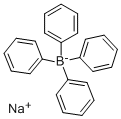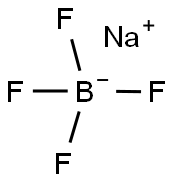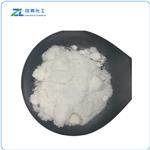
Sodium tetraphenylboron
- Product NameSodium tetraphenylboron
- CAS143-66-8
- CBNumberCB5393075
- MFC24H20BNa
- MW342.22
- EINECS205-605-5
- MDL NumberMFCD00011494
- MOL File143-66-8.mol
- MSDS FileSDS
Chemical Properties
| Melting point | 300 °C |
| bulk density | 500kg/m3 |
| storage temp. | 2-8°C |
| solubility | relatively well soluble in water. A 0.1 M aqueous solution is generally used as reagent. |
| form | Solid |
| color | White |
| PH | 8 (50g/l, H2O, 20℃) |
| Water Solubility | SOLUBLE |
| Sensitive | Light Sensitive |
| Merck | 14,8690 |
| BRN | 3599783 |
| Stability | Stable. Incompatible with strong acids, strong oxidizing agents. Light sensitive. |
| InChI | InChI=1S/C24H20B.Na/c1-5-13-21(14-6-1)25(22-15-7-2-8-16-22,23-17-9-3-10-18-23)24-19-11-4-12-20-24;/h1-20H;/q-1;+1 |
| InChIKey | HFSRCEJMTLMDLI-UHFFFAOYSA-N |
| SMILES | [B-](C1=CC=CC=C1)(C1=CC=CC=C1)(C1=CC=CC=C1)C1C=CC=CC=1.[Na+] |
| CAS DataBase Reference | 143-66-8(CAS DataBase Reference) |
| FDA UNII | 5A96KL5H1M |
| EPA Substance Registry System | Borate(1-), tetraphenyl-, sodium (143-66-8) |
Safety
| Symbol(GHS) |

|
|||||||||
| Signal word | Danger | |||||||||
| Hazard statements | H301 | |||||||||
| Precautionary statements | P301+P310 | |||||||||
| Hazard Codes | Xn,Xi | |||||||||
| Risk Statements | 22-36/37/38 | |||||||||
| Safety Statements | 26-36/37-36-24/25 | |||||||||
| RIDADR | UN 2811 6.1/PG 3 | |||||||||
| WGK Germany | 3 | |||||||||
| RTECS | ED3362500 | |||||||||
| F | 8 | |||||||||
| TSCA | Yes | |||||||||
| HazardClass | 6.1 | |||||||||
| PackingGroup | III | |||||||||
| HS Code | 29310095 | |||||||||
| Toxicity | LD50 orally in Rabbit: 288 mg/kg | |||||||||
| NFPA 704: |
|




